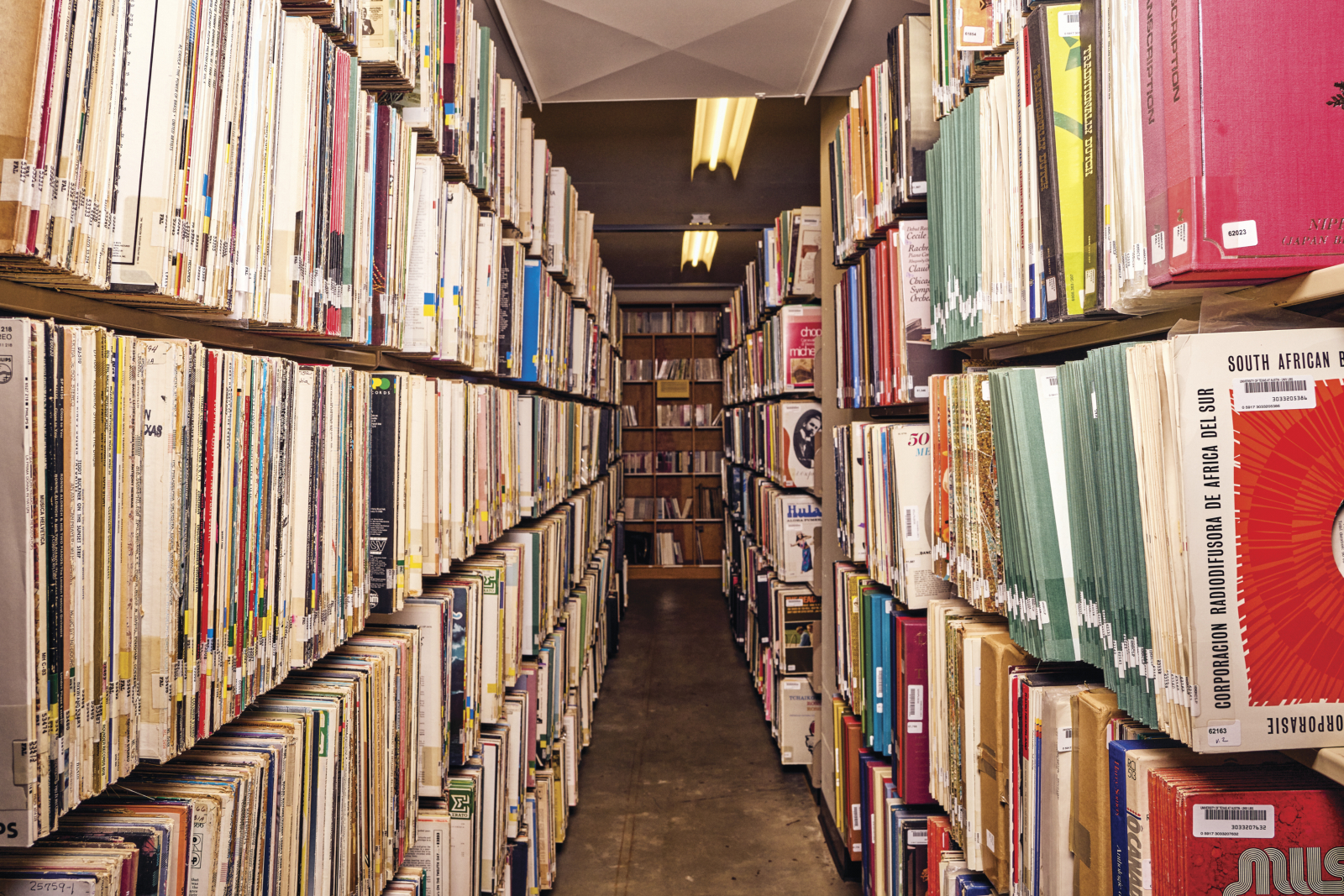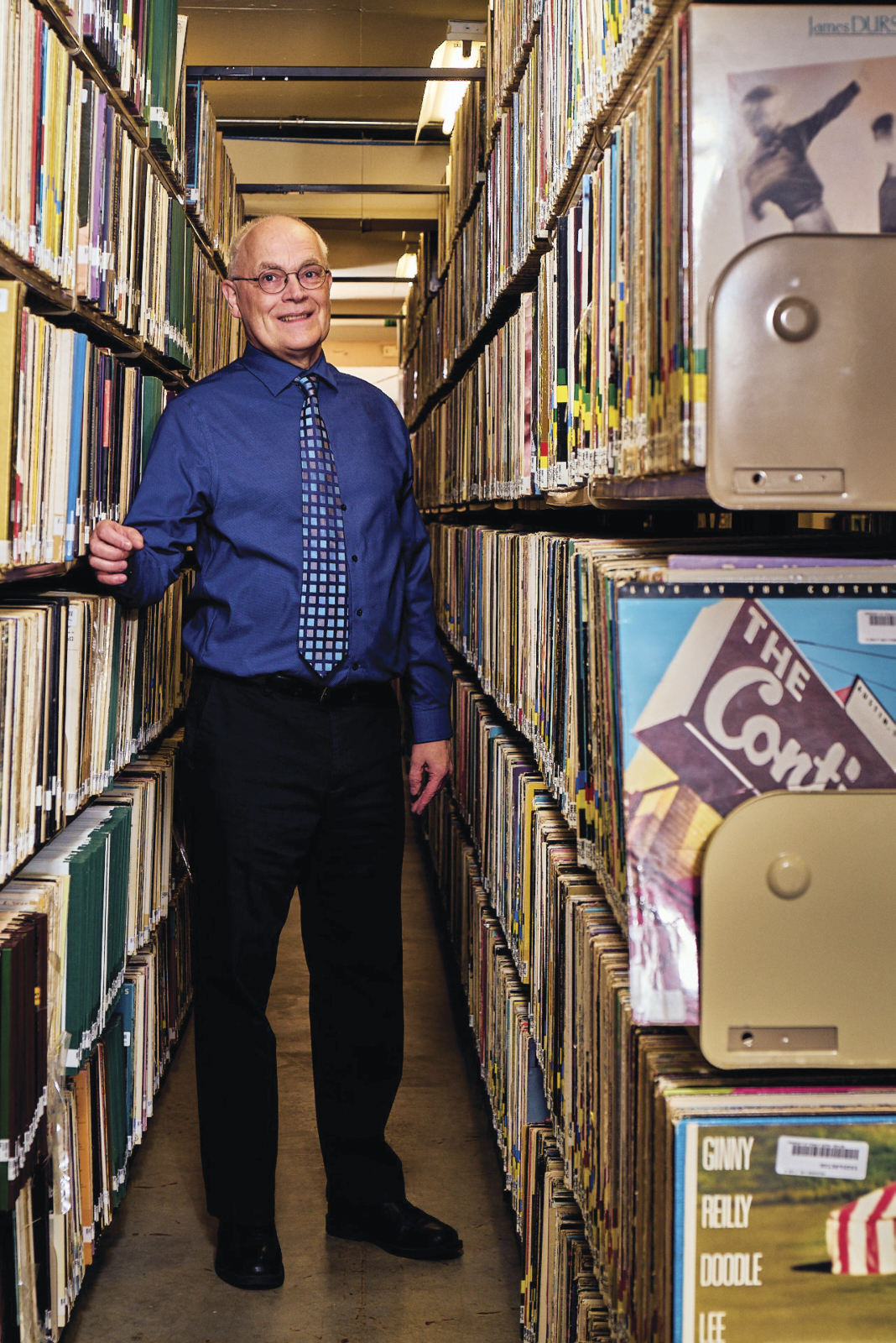UT’s Sonic Archive is a Treasure Trove of Recorded Art

Walking into UT’s Historical Music Recordings Collection (HMRC) this summer, a nondescript building shrouded by nearby construction—we were asked to keep the location top secret—I am greeted by what I consider to be the two best things in life: killer air conditioning and endless stacks of LPs.
One informs the other; the Ahmad Jamal and Bill Evans albums I’m drooling over have to stay cool and live in low humidity if they are to be useful for future scholars. It’s a crisp 68.36 degrees, according to a little white Onset HOBO data logger affixed to one of the many metal shelves that house the collection of records sorted by their Library of Congress numbers.
“Preservation is a big deal at UT Austin,” says Corinne Forstot-Burke, the humanities liaison librarian for Performing Arts. “As a general rule, it needs to be under 72 degrees and around 40- something percent humidity. It has to be cool, but not too cold and it can’t be too warm, and the humidity has to be kept low, but not so low that things dry out completely.”
But it’s not just vinyl records made by modal jazz pianists who led famous trios that the archive is charged with keeping useful for future generations. UT has been collecting and preserving musical recordings since the 1940s, before the long-playing format existed. Today, the librarians and archivists who work at the HMRC watch over around 400,000 items, including 78 rpm records, 45 rpm singles, open-reel tapes, cassette tapes, large-format transcription discs, compact discs, lacquer discs, and other formats. If someone put music to it, there’s a good chance UT has multiple versions of it somewhere in the labyrinthine stacks.
With all those formats stored in the same room, it’s a challenge to keep, say, the wax cylinders and the shellac discs—two formats with different needs in the way of environmental controls—happy forever, which is the HMRC’s ultimate goal. Forstot-Burke says there are long-term plans to build more space for preservation.
“In a perfect world, there’s cold storage in addition to temperature control,” she says. “In a perfect world, we would have multiple storage locations.”
And although the collection also houses working stand-up Edisons and Victrolas and other commercially bygone music players, some items are so unique that they simply cannot be played.
“We got a whole bunch of piano rolls from a local collector to add to our existing holdings, and we do not have a player-piano, so if anybody has an operating player-piano they would like to donate to us, that would be a great thing to add to the collection,” laughs David Hunter, librarian emeritus.
Hunter retired from UT Libraries in 2017, passing the torch to Forstot-Burke in 2019. When he arrived on campus in 1988, the HMRC was housed across campus, in the Fine Arts Library. But it had moved at least once before, along the way siphoning up donated materials and other collections and outgrowing spaces.

The basis of the collection is the 78s that belonged to UT’s music library dating back to the 1940s, which was housed in the Music Building (now Homer Rainey Hall, on the South Mall).
“All sorts of students used to hang out there in the music library and they would listen to 78s,” Hunter says. With the advent of the LP in the late 1940s, the university added more vinyl records to its collection, in addition to other tape formats. Hunter says his predecessor as music librarian, Olga Buth, persuaded UT Head of General Libraries Harold Billings to hire a recording specialist, which eventually led to the inception of the HMRC.
“It was a question of providing continuing access to recordings that were otherwise unavailable,” he says.
By that time, the music library and recordings had moved to Battle Hall. In 1980, when the fine arts complex was constructed, they were moved to the fifth floor of the Fine Arts Library.
“We didn’t have enough room then, and we still don’t really have enough,” Hunter says.
That’s because the HMRC, a major collection as far as sound archives go, has expanded as it has assumed other collections. It serves as the archive for the Austin and Houston symphony; it took over Rice University’s legacy audio materials when it decided it didn’t want to keep them; it has the complete collection of Radio House recordings, a defunct arm of the university that recorded performances at the music school in the 1940s and ’50s; and it has most of KUT’s CD collection—more than 60,000 of them, plus more than 5,000 LPs—for the usual reason: they ran out of space.
“It’s a story that is very common,” Hunter says, “and we love those stories because we can be the room for that stuff.”
Whit Williams is a content management specialist for UT libraries whose job is to catalog the KUT collection. His job—I’m infinitely jealous—is to, simply, listen to music all day, every day and log the metadata. As a musician, he uses his musical ear to distinguish between genres, making each CD easily searchable for anyone who wants to find a piece of music. Many of these CDs are demos or self-released albums that might be lost to time if not for archivists like Williams at the HMRC.
Regularly he comes across “these amazing little records,” Williams says. “From the very start, I got the idea to do a music column. I call it Whit’s Picks.” The blog, hosted at UT’s TexLibris site, highlights fantastic, mostly obscure albums written in Williams’ rock and roll poet vernacular.
“I know students aren’t rushing over to check out compact discs. I get it,” Williams says. “But it might not be available online.” Hunter tells me that there’s a perception that all of humanity’s recorded music is available somewhere online. Not so. He says that between 75 and 85 percent of commercially issued records—LPs, 78s, and 45s—remain in their initial issue format.
“We have all of this music that many people have never heard of,” Hunter says, “and that’s wonderful because otherwise it’ll just be completely lost.”
The HMRC is striking in its vastness, but part of its magnificence is the types of recordings it holds.
“The first thing you see are punk records,” Forstot-Burke says, “so that was enough for me.”
She’s referring to the Freud Reia Punk Collection, a small but exciting group of punk and new wave LPs and 45s that Reia’s family donated after he died in an auto accident in 2015. It spans sub-genres even within the sub-genre, from classic hardcore records like Minor Threat’s 1983 twelve-inch Out of Step to 1999’s dance-punk standout, the Le Tigre self-titled album. There’s even a seven-inch single by a relatively unknown group called Bucket Full of Teeth, a band that actually played my dingy New Brunswick, New Jersey, basement in 2002.
In the 1970s, UT started teaching a course on rock and roll, and thus the HMRC began collecting rock and popular music to aid in scholarship. But Hunter says that if you’re only teaching rock and roll, you miss out on some nuance, particularly in sub-genres.
“I made a point of joking about with some people who came to visit the library and I said, ‘Well, you know, we don’t teach death metal here, and it would be great if someone would support it,’” he says. “Lo and behold, they went out—they were alums—and they said, well, ‘We’ll, start sending you some death metal.’ So, we started adding death metal to the collection.”
If death metal isn’t your bag, there’s a recipe box from a woman in Corpus Christi named Henrietta Chase filled with catalog information pertaining to acetate discs of recordings she made of the Bing Crosby radio program, perhaps the only copies still in existence. There’s also the Joseph Prager collection of Jewish cantors, 78 rpm spiritual songs with contemporary photos of the singers pasted onto the spines. There are even print materials, like contemporary fanzines and record label catalogs, which Hunter says can help aid with research on audio materials. Be it the Poison Idea “Pick Your King” seven-inch single, a Bix Beiderbecke box set, or a one-of-one acetate recording of a bygone radio program, the unifying theme in this room is posterity.
“Not many institutions have had the capacity to archive to the extent that we have; not many institutions have been able to make collections as available as we have,” Hunter says. “There are hidden gems, and it’s lovely to think that we are able to move those along to future generations in the same way that we move along the printed scholarship. You can’t tell history without writing about the audio creativity of people.”
Credit: Matt Wright-Steel





